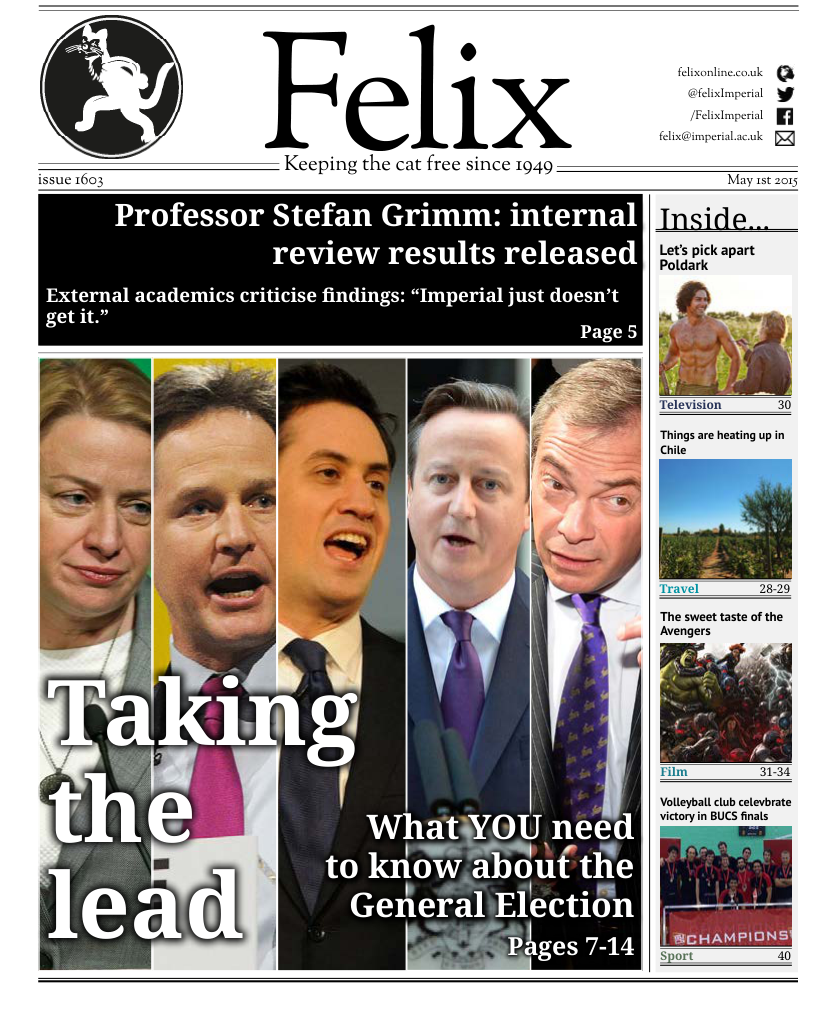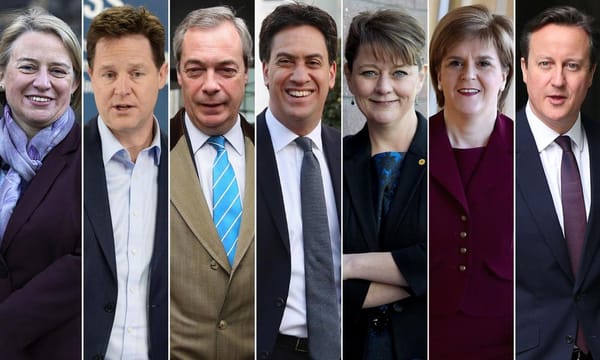Imperial students most likely to vote Conservative, Felix poll finds
35% of students will be voting Conservative next week, whilst another 30% will be choosing Labour

35% of students will be voting for the Conservative party this year, although a further 30% will be giving the Labour party their vote, our Felix opinion poll shows.
Only 18% of students are voting for the liberal democrats, a significant drop in numbers since the last general election poll that took place in 2010, when 56% said they would cast their vote for Nick Clegg and his crew. 9% of students said they would vote for the Green Party, whilst 5% said they would be giving Farage the seal of approval and voting for UKIP.
We asked a total of 189 students how likely they will be voting next Thursday in the General Elections; incredibly, 80% of students who responded said they were very likely to vote, with only 6% of respondents saying that they probably wouldn’t bother.
When we asked students to list what topics mattered most to them, 34% of respondents said the Economy was their primary concern, and a further 17% said they were most interested in healthcare. 9% of respondents listed Education as the top topic that they were most interested in.
Not surprisingly, none of the respondents listed pensions, local government or rural affairs as topics they were most concerned about, although encouragingly 8% did list the environment as something they were most interested in.
Compared with other universities, it seems Imperial has mirrored national student statistics. In a survey questioning more than 13,000 students nationwide, Labour and Conservative parties came up as equally popular, with 31% of the vote each. St Andrews students are most likely to vote for Conservative candidates, whilst the Green Party has amassed a strong support with Edinburgh University students.
Compared to national predictions from electionforcast.co.uk, at the time of print, there are similar trends between the two datasets, although it should be noted that the number of individuals voting for a party does not reflect the percentage of seats MPs will obtain in Parliament.
Conservative are expected to win 279 out of the 650 seats available, with Labour coming up close with 270. Liberal Democrats are looking at securing 27 seats, with UKIP and the Green Party winning 2 and just one seat respectively.
Five years on: the drop in Lib Dem popularity
For the last General Election in 2010, Felix ran a similar poll and found that 56% of those who responded intended to vote Liberal Democrats, 24% were going to vote for a Conservative Party candidate and only 16% were planning on casting their vote for a Labour Party candidate.
Despite this, the overwhelming majority of students still predicted that there would be Conservative win or hung parliament, which was, as we now know, the outcome of the 2010 General Election.
With Nick Clegg promising back in 2010 to scrap tuition fees, this may be how his party garnered so much student support, although they also seemed to be pessimistic about if he would ever actually take power. Back then, the Liberal Democrat manifesto also had a visibly larger portion dedicated around science policies, and had also pledged not to cut the science budget if they made it into power.
Interestingly, a YouGov poll at the time found that 49% of all voters would have actually voted for a Liberal Democrat, if they thought the party actually had a shot at winning and taking some of those safe seats from Labour or Conservative candidates.
Elections in the UK: A guide for dummies
What is a general election?
Every 5 years, residents of the UK are able to vote on candidates to represent them in the House of Commons. The UK is split into areas of roughly equal population size, called constituencies. Each constituency will have several MP candidates standing for election, with candidates often being affiliated with a main political party. Those that are not are called “Independent” candidates.
What are the main political parties in the UK?
Three parties usually dominate the House of Commons, which are the Conservative party, the Labour party and the Liberal Democrats. However, many other parties may secure a small number of seats, including the Green Party, or the United Kingdom Independence Party (UKIP). Each party has various political views and stances, which their MP candidates will generally also be in favour of.
How many MPs are there?
There is one per constituency, and there are 650 constituencies across the whole of the UK.
In London due to the high population density, there are 73 different constituencies, but generally cities have far fewer. The whole of Wales only has 40 constituencies for example, whilst Scotland has 59.
There are around 50,000 to 70,000 people in each constituency.
Who can be an MP?
Anyone can stand as a Member of Parliament; they simply need to be a British or Irish Commonwealth citizen, and over 18. They cannot be a public official or officeholder.
Who decides who is Prime Minister?
You cannot vote on who is Prime Minister, as they are, by convention, appointed by the Monarch. The individual who is considered “to command the confidence of the House of Commons” and therefore the usually the leader of the majority political party or, if there is a coalition, the leader of the party that holds the most seats will be Prime Minister.
What voting system does the general election use?
The current system is called “First Past the Post” (FPTP). This means you can only cast one vote for an MP candidate, and the candidate that receives the most vote wins that seat and represents that constituency in the House of Commons.
How does a party form the government?
Each MP has a seat in the House of Commons, and the party that wins the most seats forms the government. This means that they can put their ideas and views into practise when running the country.
A party needs to command more than half the seats to win, and the party that wins the second largest seats becomes the “opposition” party. If a party doesn’t command a majority of the seats, coalition governments may form. Parties come together until they represent the majority of seats.










